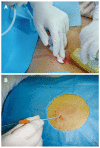Percutaneous catheter drainage in combination with choledochoscope-guided debridement in treatment of peripancreatic infection
- PMID: 20101781
- PMCID: PMC2811808
- DOI: 10.3748/wjg.v16.i4.513
Percutaneous catheter drainage in combination with choledochoscope-guided debridement in treatment of peripancreatic infection
Abstract
Aim: To introduce and evaluate the new method used in treatment of pancreatic and peripancreatic infections secondary to severe acute pancreatitis (SAP).
Methods: A total of 42 SAP patients initially underwent ultrasound-guided percutaneous puncture and catheterization. An 8-Fr drainage catheter was used to drain the infected peripancreatic necrotic foci for 3-5 d. The sinus tract of the drainage catheter was expanded gradually with a skin expander, and the 8-Fr drainage catheter was replaced with a 22-Fr drainage tube after 7-10 d. Choledochoscope-guided debridement was performed repeatedly until the infected peripancreatic tissue was effectively removed through the drainage sinus tract.
Results: Among the 42 patients, the infected peripancreatic tissue or abscess was completely removed from 38 patients and elective cyst-jejunum anastomosis was performed in 4 patients due to formation of pancreatic pseudocysts. No death and complication occurred during the procedure.
Conclusion: Percutaneous catheter drainage in combination with choledochoscope-guided debridement is a simple, safe and reliable treatment procedure for peripancreatic infections secondary to SAP.
Figures



Comment in
-
Comments on the article about the treatment of peripancreatic infection.World J Gastroenterol. 2010 May 14;16(18):2321-2. doi: 10.3748/wjg.v16.i18.2321. World J Gastroenterol. 2010. PMID: 20458775 Free PMC article.
Similar articles
-
[Ultrasound-guided percutaneous tube drainage combined with directly-viewed debridement with cholangioscopy: a mini-invasive strategy for peripancreatic necrotizing infection].Zhonghua Wai Ke Za Zhi. 2008 Nov 1;46(21):1630-3. Zhonghua Wai Ke Za Zhi. 2008. PMID: 19094757 Chinese.
-
Comments on the article about the treatment of peripancreatic infection.World J Gastroenterol. 2010 May 14;16(18):2321-2. doi: 10.3748/wjg.v16.i18.2321. World J Gastroenterol. 2010. PMID: 20458775 Free PMC article.
-
Retroperitoneal laparoscopic debridement and drainage of infected retroperitoneal necrosis in severe acute pancreatitis.Asian J Surg. 2013 Oct;36(4):159-64. doi: 10.1016/j.asjsur.2013.04.003. Epub 2013 Jun 17. Asian J Surg. 2013. PMID: 23786806
-
Interventional radiology in the management of abdominal collections after distal pancreatectomy: a retrospective review.AJR Am J Roentgenol. 2011 Jul;197(1):241-6. doi: 10.2214/AJR.10.5447. AJR Am J Roentgenol. 2011. PMID: 21701036 Review.
-
American Gastroenterological Association Clinical Practice Update: Management of Pancreatic Necrosis.Gastroenterology. 2020 Jan;158(1):67-75.e1. doi: 10.1053/j.gastro.2019.07.064. Epub 2019 Aug 31. Gastroenterology. 2020. PMID: 31479658 Review.
Cited by
-
Minimally invasive treatment of infected pancreatic necrosis.Prz Gastroenterol. 2014;9(6):317-24. doi: 10.5114/pg.2014.47893. Epub 2014 Dec 30. Prz Gastroenterol. 2014. PMID: 25653725 Free PMC article. Review.
-
Controversies in EUS-guided treatment of walled-off necrosis.Endosc Ultrasound. 2022 Nov-Dec;11(6):442-457. doi: 10.4103/EUS-D-21-00189. Endosc Ultrasound. 2022. PMID: 35313415 Free PMC article. Review.
-
Percutaneous Endoscopic Necrosectomy of Complex Walled-Off Lateral Necrosis of the Pancreas with the Aid of Laparoscopic Babcock Forceps: A Case Report of an Endoscopic and Radiologic Team Approach.Perm J. 2019;23:18-230. doi: 10.7812/TPP/18-230. Epub 2019 Jun 21. Perm J. 2019. PMID: 31314716 Free PMC article.
-
Successful Resolution of Gastric Outlet Obstruction Caused by Pancreatic Pseudocyst or Walled-Off Necrosis After Acute Pancreatitis: The Role of Percutaneous Catheter Drainage.Pancreas. 2015 Nov;44(8):1290-5. doi: 10.1097/MPA.0000000000000429. Pancreas. 2015. PMID: 26465954 Free PMC article.
-
Management of enterocutaneous (jejunocutaneous) fistulas with NBCA glue injection: A case report.Radiol Case Rep. 2025 May 12;20(8):3675-3679. doi: 10.1016/j.radcr.2025.04.038. eCollection 2025 Aug. Radiol Case Rep. 2025. PMID: 40475039 Free PMC article.
References
-
- Beger HG, Rau B, Mayer J, Pralle U. Natural course of acute pancreatitis. World J Surg. 1997;21:130–135. - PubMed
-
- Werner J, Hartwig W, Hackert T, Büchler MW. Surgery in the treatment of acute pancreatitis--open pancreatic necrosectomy. Scand J Surg. 2005;94:130–134. - PubMed
-
- Banks PA, Freeman ML. Practice guidelines in acute pancreatitis. Am J Gastroenterol. 2006;101:2379–2400. - PubMed
-
- Balthazar EJ. Complications of acute pancreatitis: clinical and CT evaluation. Radiol Clin North Am. 2002;40:1211–1227. - PubMed
-
- Bouvet M, Moussa AR. Pancreatic abscess. In: Cameron JL, editor. Current surgical therapy. 8th ed. Philadelphia: Elsevier Mosby; 2004. pp. 476–480.
Publication types
MeSH terms
LinkOut - more resources
Full Text Sources
Miscellaneous

